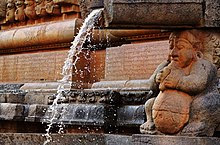The architects of ancient India centuries ago were highly skilled, imaginative and well-versed in civil engineering with respect to design and load-bearing aspects. They also had richly talented stone sculptors who could translate their dreams into reality. If you take a Hindu temple you will run into a plethora of stone sculptures of splendor and beauty, tall ornate pillars with strange creatures, vast mantaps of different sizes to conduct temple functions, tall towers - gopuras etc. They built temples as per temple shastras and strictly followed norms of temple architecture that define construction of various parts of the temple in a particular fashion more than 1100 years ago. Among the various features of the temple, Pranala - water spout, a simple feature to drain out the abhisheka water or liquid is an interesting one. .
 |
| 11CE Makara-Pranala (water spout),Shamlalji temple,GJ aupload.wikimedia.org |
Above image: In Hindu mythology Makara is a sea creature roughly equal to the Zodiac sign of Capricorn............
In Hindu temple architecture, a pranala or pranalu is a discharge outlet primarily attached to the wall of the sanctum or temple's jagati (platform). The main purpose of pranala is to drain out the abhisheka water, milk, and other liquid poured over the main idols- either Moolavar stone idols or festival metal idols. The holy water or other liquids poured over the idols will be collected outside and cleared periodically. Ablution of Shiva linga in the sanctum- garbagriha in all Shiva temple is a main puja ritual and at many temples it is done daily in the morning. On festival days abhisheka of Shiva linga is a must. The abhisheka water or liquid that exits on the prakara is available to the worshippers
According to historians the earliest pranalas appeared in the Shaka-Kushana period -3rd CE in northern India. Though the concept of pranala was adopted by many rulers including the Guptas as part of Hindu temple architecture, it was in the 8th century CE talented sculptors came up with imaginative features and sculptured them in strange but striking forms - mostly in sea-animal forms. The pranalas continued to be used in the subsequent years, including the Gupta period. in the later years pranalas became part of Hindu temple architecture across India.
Though architectural tradition allows several forms of Pranala - water outlet, the most common is Makara Mukha (crocodile face). Go-Mukha (cow-face), Gaja Mukha (elephant) are rare. In all historical Hindu temples invariably the common form adopted is Makara. Makara pranala (or pranali) may come in different sizes.
Ancient texts on architecture -Samarangana Sutradhara, (11th century), Vishvakarma's Vastushastra, compendium on the Māru-Gurjara architecture (late 11th century) and Aparajita-prchchha (12th to early 13th century), refers to the makara-pranala depicting the mythical sea-creature makara (also known as graha).
It more or less resembles the European gargoyles fixed on the outer part of the buildings to drain out the rain water. But they adopt a vast spectrum of shapes and not confined to a few forms.
Next to makara the grasa-pranala is a common feature; this depicts the grasa, also known as kirtimukha (mythical creature a swallowing fierce monster face with huge fangs, and gaping mouth, common in the iconography of Hindu temple architecture). Grasa-pranala which is common in south Indian temples may be compared with Gorgons of the Greek mythology; rare in north Indian temples. The simha-pranala, which depicts a lion, is similar to the grasa-pranala.
 |
| Pranala water spout-Chola temple, GK.cholapuram? dreamstime.com |
 |
| Pranala at the Brihadisvara Temple Facebook |
 |
| water discharge chidambaramhiddentreasure.com 8th CE Kailasanathar rock-cut temple. |
 |
| Water outlet, 8th CE Shiva temple. reddit.com |
Pranala : The water outlet of Shiva temple at Markand The temple was built in 8th Century ( about 1200 years old)
 |
| Black stone pranala 800-800 CE, Vellore |
 |
| Pranala Malava style Drainage outlet upload.wikimedia.org |
.jpg) |
| Pranala, chidambaramhiddentreasure.com Chidambaram temple. |
 |
| water spout- crocodile holding fish, Konarak temple agefotostock.com |
.jpg) |
| Pranala in Aghoreshwara temple, KA. Facebook.com |
Above image Pranala, Nayak period. Aghoreshwara temple, Shimoga dist., KA Note Indira on an elephant Airavata
 |
| Makara-pranala at Borobudur, Indonesia upload.wikimedia.org |
 |
| Makara-pranala at Lakshmi Devi Temple upload.wikimedia.org |
 |
| Pranala,Someshwar temple in Bhangarh Fort upload.wikimedia.org |
 |
| A makara-pranala at the Hazara Rama temple upload.wikimedia.org |
 |
| water spout, Thanjavur Big temple, upload.wikimedia.org |
 |
| water spout, Thanjavur Big temple, upload.wikimedia.org |
Above images: Pranala at the Brihadisvara Temple, north prakara (outer courtyard) Thanjavur,Tamil Nadu -
https://www.chidambaramhiddentreasure.com/kailash-pranala-waterspout/


.jfif)
.jfif)





